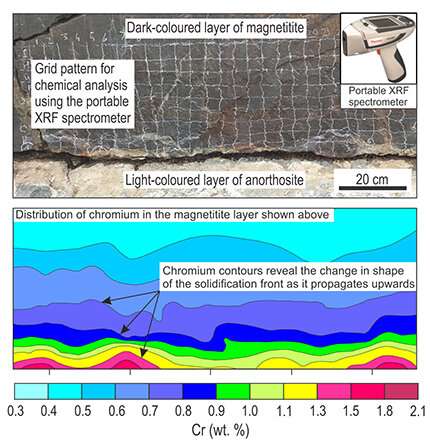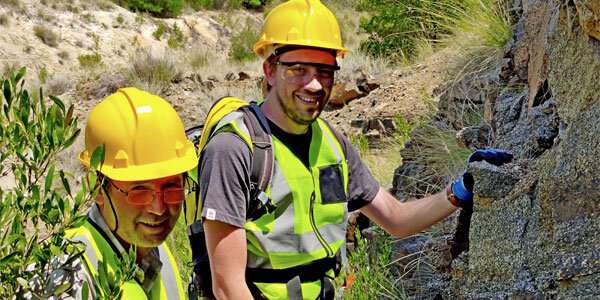Credit: Wits University
Research conducted by a Ph.D. student at the Wits School of Geosciences reveals that basaltic magma chambers may develop as large bodies of crystal-free melts in the Earth's crust. This study challenges a recently-emerged paradigm that magma chambers are huge masses of crystal-rich mush—in other words, crystals with just a very small amount of melt.
Attempts to understand the processes that operate in magma chambers in our planet's crust is incredibly challenging as they are hidden from direct observations. Geologists must follow an indirect approach to study these features, such as examining their ancient fossilized remains that are exposed on Earth's surface after millions of years of erosion.
To examine the state of magma within a chamber is very demanding, as it requires the study of the very contact between the crystallizing margins of magma bodies (also called solidification fronts) and their liquid interiors.
Difficulties in understanding the behavior of solidification fronts can fortunately be overcome by studying a particularly fascinating rock type, called massive magnetitite, from the Bushveld Complex in South Africa.
"Magnetitite contains chromium that is an extremely sensitive indicator of magma chamber processes and can be used to study solidification fronts in extreme detail," says Willem Kruger, a Ph.D. student who conducted the study.
"By mapping the distribution of chromium in magnetitite in the field we can observe the two-dimensional propagation patterns of solidification fronts on a scale never done before."
Credit: Wits University
Kruger and his Ph.D. supervisor, Professor Rais Latypov, found that all evolved liquid is effectively removed from the solidification front of magnetitite as it propagates towards the chamber interior. "This is because of extremely effective compositional convection that occurs during the crystallization of magnetite. The process results in the solidification front to propagate as almost a completely solid surface." says Latypov.
This research shows that such powerful compositional convection may inhibit the formation of crystal-rich mushes in basaltic magma chambers.
There are many reasons to believe that this process is not unique to magnetitite layers of the Bushveld Complex but will likely operate in other rock types as well, for instance, in the Bushveld's economically important chromitite layers.
"Our results thus argue for the existence of large, liquid-dominated magma chambers hidden within the Earth's crust," says Kruger.
More information: Willem Kruger et al. Fossilized solidifications fronts in the Bushveld Complex argues for liquid-dominated magmatic systems, Nature Communications (2020). DOI: 10.1038/s41467-020-16723-6
Journal information: Nature Communications
Provided by Wits University
























